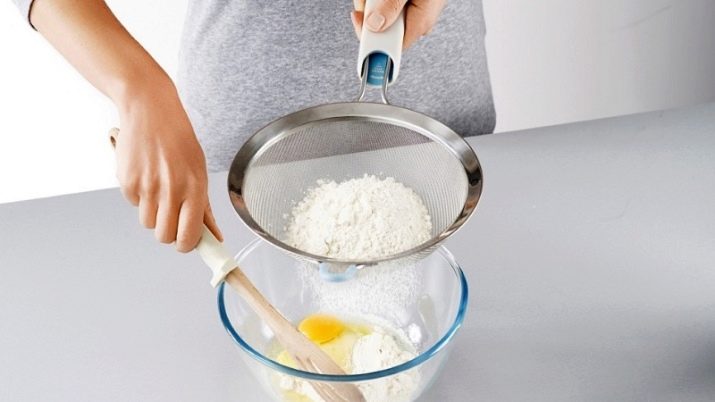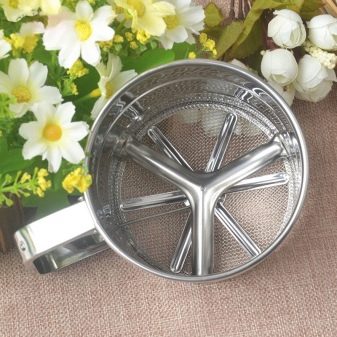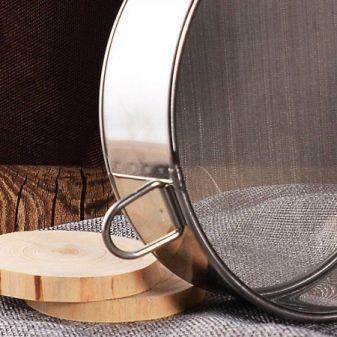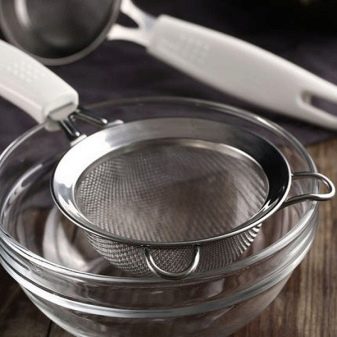Sieve for flour: types, features of selection and operation

Cooking is one of the most complex and challenging areas of human endeavor. There are a number of processes that need to be performed and monitored during food preparation. For example, working with flour is especially difficult. Before adding this ingredient to any dish, make sure it is clean and free of any impurities. For this, the flour is sieved through a sieve.
A wide range of kitchen utensils can be found on the market today. Sieves are no exception. Manufacturers and sellers offer consumers a wide variety of types of this kitchen appliance. What type of sieve to choose and how to use it correctly - read our article. Here you will learn all the intricacies of using this item, as well as find answers to all your questions.


Description
A sieve is a flour sifter that can be found in almost every kitchen today. Despite the fact that this device is quite popular today, it first appeared in ancient times. Over the years of its existence, the sieve has repeatedly changed its appearance, from a functional point of view, remaining the same practical piece of kitchen decoration.
In general, if we describe the appearance and general design of any sieve, then it should be said that this object is a kind of body on which a lattice is fixed. It is understood that it is through this grate that this or that product should be sifted (in most cases, flour).As we can see, the design of the device is quite simple, but nevertheless, it is quite effective and helps to solve a variety of culinary problems.
The sieve can be made of various materials: today, on the market and in stores, you can buy household appliances made of metal, plastic or wood. Moreover, the lattice is usually made of plastic or hair mesh.
The mechanism of the sieve is quite simple: the device at the moment of direct operation must be in continuous motion. This rule ensures uniform and thorough sifting - flour does not clog into the holes of the sieve.


What is a sieve for?
A sieve is a universal device that no housewife can do without. Despite the fact that today on the market you can find a wide variety of organic products, semi-finished and ready-to-eat foods, some gaps in this regard still remain. For example, flour purchased from a store cannot be used immediately for cooking (baked goods, sauces). This product must pass a kind of preparatory process before becoming an ingredient in any dish - the flour must be sifted.
First of all, sowing flour is necessary in order to get rid of various kinds of mechanical impurities that may be contained in this product. This process is relevant regardless of what particular dish you plan to cook. In addition, it is believed that flour must be sieved before adding it to the dough. Through this procedure, you will significantly improve the quality of the final product - your baked goods will be softer and fluffier.
Thus, despite the fact that by its nature the sieve is a rather primitive device, its role is irreplaceable in relation to cooking. This device is actively used by both amateur housewives and professional chefs, employees of elite restaurants and other places of public catering.

Views
There is a huge variety of sieve variations on the market today. This kitchen appliance has significantly evolved in its appearance, as well as in terms of the comfort of its use.
Sieve mug
So, one of the simplest, but at the same time popular and widespread mechanisms is a mechanical kitchen hand sieve with a handle, which is made in the shape of a mug. Such a device can be found in almost any store with kitchen utensils, and it is very inexpensive. Despite the fact that the mechanism of the sieve mug is quite simple, it is at the same time quite effective, copes well with its functions.
Often this hand sieve is made of metal. The mug has no bottom - instead of the traditional bottom, there is the same sieve. For convenience and comfort during operation, the mug is endowed with a special handle, which, in turn, consists of two parts and has a built-in spring. In order to carry out the sifting process, you need to pour the flour into the mug, and then press the handle. By this pressing, the sieve is automatically put into operation: flour passes through small holes and pours out already sifted into a container you have prepared in advance. On the other hand, all non-sifted elements and particles remain on the inner surface of the sieve.
Such a sieve has a number of advantages, thanks to which it has become popular among housewives. So, for example, it is quite easy to use due to its small size. In addition, the compactness of the device ensures a clean and tidy workplace. The sieve design is quite attractive and modern. The disadvantage of a mug sieve is that it is not suitable for industrial use. It is convenient to use only if you need to sift a fairly small amount of flour.
The sieve mug is a device for home use.


Traditional round
A more traditional option is a large round wooden sieve. Such a device was used not only by our mothers and grandmothers, but also by our more distant ancestors. Despite this, however, this option for sifting flour remains quite popular and can be found in many kitchens.
By its structure, a wooden sieve is nothing more than a wooden hoop, on one side of which a mesh with cells is fixed. In order to carry out the sieving procedure, the sieve must be moved from side to side, performing a kind of shaking motion. It is believed that a wooden sieve is the most environmentally friendly version of such a device, which will serve you for many years and will not harm the sifted product.
The main disadvantage of such a sieve is that Due to its large size and diameter, it is impossible to ensure a clean workplace. Flour can fly in all directions.
A less environmentally friendly, but more modern analogue of a wooden one is a plastic sieve.


Metallic with handle
Another common sieve model is a metal sieve with a handle. Outwardly, this device may resemble a bucket. However, the bottom is not solid, but consists of a mesh with cells, which performs the function of sifting. The construction of this sieve is not similar to those described above. The main difference is the surface of the sieve, which is not straight, but has a depression. This deepening increases efficiency and speeds up the screening process.
Thus, today on the market you can find a kitchen device for sifting flour in accordance with any wishes and needs. For example, a sieve mug is suitable for housewives who are fond of baking, and a wooden sieve is an excellent option for sifting flour on a larger scale.


How to choose?
Generally speaking, the choice of a sieve is a purely personal matter for every culinary specialist. There are a few simple principles to keep in mind when buying this device.
- The size of the cell can be important. As a general rule, it is believed that the lower this indicator, the cleaner and higher quality flour will be at the output.
- Construction is another important characteristic. Despite the fact that one of the most popular models is a sieve mug, the device of this device is not convenient for everyone. In this regard, you need to approach the choice individually.
- Price also plays a role. In general, the cost of such a device is quite low. However, the cheapest are traditional sieve options - wood and plastic.
- When choosing an appliance, consider the scale and volume in which you will have to sift the flour.
- Try to choose options that are suitable not only for sifting flour, but also for processing other products (such as cocoa).
So, with all the tips in mind, you can't go wrong with your choice.


Usage Tips
The rules for operating the device are quite simple, however, do not forget to take good care of this kitchen utensil.
- After each use, it must be washed or cleaned - this is especially true if you process not only flour, but also other ingredients in this device. In this sense, a wooden sieve should be handled most carefully, since such a material does not like excess moisture and is able to absorb odors.
- If in the process of washing you use detergents or chemical solutions, then thoroughly rinse the device so that no microparticles remain on the surface and inside the mesh cells. Otherwise, during the subsequent use of the device, the sieved product may begin to interact with the remains of cleaning chemicals.
- It is recommended to store the sieve in a dry and clean place - this way you will extend the life of this device.
- If you are using large-diameter models (wood, plastic or metal), then try to work as carefully as possible. If you ignore this rule, then flour can be on all surfaces of your kitchen, and you will have to carry out additional cleaning.


From the above, we can conclude that a sieve is a device that came to us from ancient times. Despite the fact that over time the design and appearance has undergone repeated changes, the functional features of this piece of kitchen utensils have remained the same.
Therefore, if your family has a sieve that your grandmother or even great-grandmother used, then do not rush to get rid of this device - it may well replace newer and more modern options.
In the next video, you will find an overview of a mug for sifting flour.








